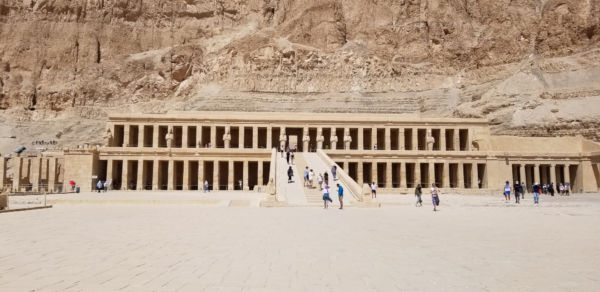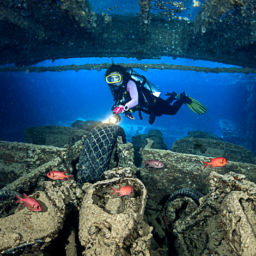One does not come all the way to Egypt to dive in the Red Sea and bypass the country’s breathtaking cultural attractions—at least this one does not. And so it is that, after a fantastic week on board the M/V Grand Sea Explorer, I’m meeting my friend Julie in Hurghada for a tour of Egypt’s land-based sites.
Organized for dive guests through the Grand Sea Explorer, our trip is an optional add-on before or after any liveaboard tour. These bespoke experiences are set up as guests wish—a few days in Cairo or Luxor, a visit to Aswan or Abu Simbel—and we’ve opted for a week-long itinerary that encompasses the greatest hits. We’ll start in Hurghada with a private driver, who will transport us to Luxor, where we’ll spend two days. From there it’s further south to Aswan and Abu Simbel, and finally a flight to Cairo for two days before heading home. The sheer scope of the history we’re about to see could—and has—filled libraries full of books, so let it be said that this short story cannot possibly summarize what we saw on our visit. I’ll focus instead on highlights and leave it to you, dear readers, to dig deeper into the history of any particular topic that strikes your fancy.
Luxor
“Habibi means sweetheart, so that’s our call sign,” says our guide, Nermeen Melad. “In a crowded place, I say habibi, you answer the same.” We meet Nermeen upon arrival in Luxor, which rises like an oasis out of the brown land, hugging the east bank of the Nile. This remarkable river is distinct not only for being the world’s longest, but also for flowing from south to north. So, confusingly (at least for us), we’re starting our tour in Upper Egypt, meaning the southern portion of the country.
Nermeen, a Luxor native, picks us up at our hotel, the Steigenberger Nile Palace, after lunch and a swim at the Nile-front hotel’s pool. Our first stop is the magnificent Karnak Temple, which can get crowded—hence her habibi call and response. Turns out we don’t need it though; the crowds are pretty light on this sweltering September day.
Throughout the trip, I find myself in an almost perpetual state of awe at the sheer age—and size—of everything we see, starting with Karnak. Encompassing about 200 acres, the massive temple complex was built to honor the sun god, Amun, his wife Mut, and their sun Khonsu, with each successive pharaoh putting his stamp on it. Reigning from ca. 1291 to 1279 BC, the pharaoh Sety I’s contribution stands out—the Great Hypostyle Hall, an enormous forest of 134 gigantic sandstone columns, originally built to support a heavy roof. Atop each column sits a lotus; the closed flowers meant to support the weight of the roof, and the open ones meant purely for decoration. And though today most of the color has washed away, we can still see glimpses of the jewel-like tones that once adorned these columns.
Our second stop of the day is the Luxor Temple, connected to the Karnak complex via the ancient Avenue of Sphinxes, lined—as the name implies— with sphinxes. Today, it’s been excavated, and visitors can walk the length of the road, roughly 1.7 miles or 3 km, though we opt to drive in the heat.
Luxor Temple, though smaller than Karnak, is no less impressive. Built around 1400 BC by Amenhotep III (1390–1352 BC) and completed by Tutankhamun (1336–1327 BC), it’s Ramses II, (1303–1213 BC), who added onto the temple, that exerts the strongest visual influence here. Flanking the entrance are two gigantic statues of the pharaoh, 46 feet tall. Already larger than life in his own time, this influential king was the father to well over 100 children, and he’ll pop up again all over the place during the week.
With our first day spent in the temples, the second day is reserved for the tombs. Because the sun sets in the west, the western bank of the Nile symbolized the end of life for ancient Egyptians, so it’s here that you’ll find both the Valley of the Kings and the Valley of the Queens. Nermeen starts our day at the Valley of the Queens, visiting the two monumental sites in the opposite order from most tours so that we don’t have to contend with crowds. Her ploy works, and as we trek into the valley from the parking lot, we see two or three other people at most.
There are more than 90 known tombs here, all built from 1292–1075 BC. Tombs open and close on a rotational basis for preservation’s sake, and our first stop is the tomb of Nefertari, the first and most beloved wife of Ramses II. Only reopened in 1995 after many years of restoration, the tomb requires an extra ticket, but it’s well worth it. Built around 1250 BC and covered from floor-to-ceiling in stunning hieroglyphs that look as though they were painted yesterday, this breathtaking underground space offers an astonishing level of artisanship.
After the Queens, we’re off to visit the Kings, who occupy a far more impressive valley (who’s surprised?). There are 63 known tombs here, built between 1539–1075 BC, also open on a rotational basis. We’ve got to take a tram up to the tombs, where our ticket includes visits to three of them—we’ve chosen those of Ramses I, Ramses III, and Merenptah, Ramses II’s 13th son and successor—each of which consists of a long, sloping corridor descending downward and carved through solid limestone, terminating in the burial chamber itself. Upper chambers along the way would have held items the king would need in the afterlife, including such modern-day essentials as beer and wine. It’s hard to describe the scope of each tomb, each long hallway covered in elaborate, colored hieroglyphs, each ending in an enormous sarcophagus that would have held the Pharoah’s mummy.

The rest of our second day is spent touring the spectacular mortuary temple of Hatshepsut, one of a few female Pharaohs. Carved into sheer cliffs, it’s three terraces are like nothing else we’ve seen—or will see—anywhere else on the trip. After two (very) full days in Luxor, the next morning brings an early departure to our next stop: Aswan.
Edfu and Kom Ombo
Our trip becomes somewhat of a whirlwind at this point, which I suppose is to be expected when you try to take in 5,000 years of history in a week. Though there’s a bypass road from Luxor to Aswan in the far south, we take the scenic route, hugging the Nile Valley all the way. Both Julie and I continually marvel at the scope of a civilization that was confined to this tiny strip of fertile land on either side of a vast desert.
On the way, we stop at two more temples. Edfu Temple, dedicated to Horus, the falcon-headed god and son of Isis and Osiris, was built from 237–57 BC, relatively new by comparison to the tombs and temples we’ve just seen. It fell into disrepair and spent many centuries covered by sand until rediscovery in 1813 by French Egyptologist Auguste Mariette.
Our next stop is Kom Ombo, which means “Hill of Gold,” constructed from 205–180 BC. This temple is unique due to its double design, with two sets of courts, halls, sanctuaries, and rooms, each meant for worship of a different god—the crocodile deity Sobek and Horus, once again. And, speaking of crocodiles, we stop into an absolute can’t miss here—the Crocodile Museum, filled with the mummified bodies of 22 enormous Nile crocodiles. Because they represented a physical manifestation of Sobek, live crocodiles were often worshiped and cared for by priests and, after they died, their bodies would be mummified.
Aswan
“They’ll take you to a garden; that’s enough temples for today,” says Nermeen upon arrival in Aswan. We’re meeting our next guide, Galal Kayed, at the Mövenpick Aswan on Elephantine Island, our luxurious hotel for (unfortunately) just the one night. After stashing our bags in our Nile-view room, we hop on board a felucca for what proves to be one of the trip’s most relaxing afternoons. Our first stop is the Aswan Botanical Garden, which occupies Kitchener’s Island to the west of Elephantine. Both islands float in the middle of the river, with greater Aswan to the east. Just as in Luxor, the city is built on the east bank of the Nile, as the western side was reserved for the dead.
After a slow stroll through the 16-acre garden, featuring plants from around the world, we board the felucca once again for a several-hour cruise on the Nile. It’s just us, Galal, a boat captain, and his assistant on the boat and, as the sun starts to set while we sip our tea and drift with the wind, Galal, who’s been a guide since 2007, tells us a bit about Aswan.
Most famous as the location of the Aswan High Dam, construction of which created the enormous reservoir Lake Nasser, the city itself is home to several can’t-miss sites, including the Unfinished Obelisk—one of Hatshepsut’s—and the Philae Temple complex, originally on Philae Island, but dismantled piece by piece and moved to nearby Agilkia Island to preserve it from being flooded when the dam was completed in 1970. Unfortunately, we do miss them both—and everything else in Aswan, aside from a very quick visit to the Dam—because of travel snafus the next day. We do, however, make it to Abu Simbel, which I’m thankful that Julie was intent on including in our itinerary.
Abu Simbel
Construction of the Aswan High Dam in the 1960s and 70s threatened quite a few ancient Egyptian monuments with submersion, including the astonishing pair of temples at Abu Simbel, built in 1244 BC. To reach this isolated site, we’ve got to be at the Aswan airport early—like 5 am early. We’re to fly to Abu Simbel, 174 miles (280 km) south, visit the temples for several hours, return the same day, tour Aswan, and then fly to Cairo that same night. But, as is common in travel, the day does not go according to plan, and our flight to Abu Simbel is so severely delayed that we miss our entire day in Aswan. Nonetheless, we’re both gob smacked by the temples when we do arrive, albeit several hours late.
Just as at Philae, the temples at Abu Simbel weren’t originally located here, on the shore of Lake Nasser, but rather in a valley that was flooded when the High Dam was completed. These temples—the larger of the two dedicated to Ramses II and the smaller to his queen Nefertari—were relocated starting in 1964, piece by piece, over 200 feet (65 m) higher up and 650 feet (200 m) further inland. And because the temples were originally carved straight into a cliff, and not constructed of pieces of stone, the rock above the temple roofs had to be peeled off to gain access. Then, each temple was carefully sawed into enormous blocks, each weighing between 20 and 30 tons—over 1,000 of them. Each numbered piece was meticulously put back into place, at exactly the same alignment to the sun as the original so that its rays would still illuminate the interior statues as before.
Today, a visit to Abu Simbel is almost as much about the sheer magnificence of the engineering feat that got it here as about the magnificence of the temples—almost. Ramses’ enormous temple is flanked by four colossal depictions of himself, each measuring 65 feet (20 m) high. Inside are more towering statues of the Pharoah and walls covered in intricate hieroglyphs, depicting his glorious military victories. The smaller temple on the site features four statues of Ramses and two of Nefertari, still enormous at around 30 feet tall (10 m). Simpler than the main temple, this one still holds impressive depictions of the queen’s coronation by two ancient goddesses, as well as ubiquitous hieroglyphs and carved scenes. After taking our time, and many pictures, we head back to the airport and, after a quick trip to the top of the Aswan High Dam, we’re on the way to Cairo for the final leg of our trip.
Cairo
“If you want to drive in Cairo, you need three things—a good horn, good brakes…and good luck.” Our guide for the next two days, Ereny George is not wrong. She and our driver meet us the next morning at our downtown hotel, the Ramses Hilton for our visit to the trip’s main event: the Pyramids of Giza. After the relative quiet of Luxor and Aswan, the cacophony of Cairo, a pulsing city of 21.7 million people, is astonishing to the senses—car horns beep 24/7; there seem to be no actual lanes of traffic; and there are people everywhere, all the time.
Here, just as in other Egyptian cities, the dead were buried on the western bank, so that’s where we’re headed. Giza today is an enormous city in its own right, contributing just over 8 million people to Cairo’s total population. But, even surrounded by so much modernity, the first glimpse of the pyramids from the car is truly breathtaking. It’s a strange feeling to see something in person, finally, that you’ve seen depicted so many times in art, movies, books, and popular culture. We’re here relatively early in the morning and in the shoulder season, so it’s not overly crowded when we disembark the car, already snapping pictures before we’re even through the entrance gate. There are three well-known pyramids on the Giza Plateau—The Great Pyramid of Giza, also known as the Khufu Pyramid or Cheops Pyramid for the king formerly buried within; the pyramid of Khafre; and the pyramid of Menkaure, also named for the kings they entombed. Though these three are by far the most famous, Ereny tells us there are over 130 pyramids in Egypt, with nine at the Giza Plateau plus the remains of 10 more.
“Do you know how many blocks are in the Great Pyramid? I’ll give you time to count,” says Ereny as we approach the entrance. The answer, she quickly shares, is 2.3 million, and the towering structure took a little over 20 years to build.
The Great Pyramid originally stood 481 feet (146 m) tall and was covered in smooth, white limestone over the now jagged-looking bricks. As it eroded, the pyramid’s height fell to a still astounding 454 feet (138 m), especially when one considers that this was all done by hand. Even more mind-boggling are the pyramid’s ages—built in the 26th and 25th centuries BC (roughly 2,600 BC–2,400 BC), these structures predate the first construction at Karnak Temple in Luxor, which was begun around 1971 BC, by over 600 years.
Though visitors have long been disallowed from climbing the outside of the pyramids, they can go inside all three; and we’ve opted for the Great Pyramid. Entrance is through a hole on the pyramid’s north face and, after a short walk through a tunnel, we’ve got to walk up a steeply slanted, extremely hot, extremely claustrophobic ramp through the Grand Gallery, less than 7 feet wide, over 150 feet long, and around 30 feet high. The long ramp leads—slightly anti-climatically—to the King’s Chamber, holding only an empty granite sarcophagus. That said, just knowing we’re climbing inside the only one remaining of the Seven Wonders of the Ancient World is thrill enough.
After our climb, it’s off to see the Great Sphinx of Giza, whose nose-less visage is just as famous as the pyramids themselves. Carved around 2,500 BC of solid limestone with the head of a human and the body of a lion, the Sphinx seems to represent the Pharoah Khafre. After the Giza burial site was abandoned, the remarkable statue spent many years buried up to it shoulders in sand. The first excavation attempt took place around 1,400 BC, but incredibly the full statue wasn’t excavated entirely until the 1930s.
With visits to the Giza pyramids and the Sphinx behind us, we spend the next day visiting the Egyptian Museum—a landmark in its own right—in downtown Cairo. Built in 1902, it now houses many of the treasures found in King Tutankhamen’s tomb, innumerable mummies, papyrus, ancient statues, sarcophagi, jewelry, and more. Two hours there barely scratches the surface, and although many of the museum’s pieces have already been moved to the as yet unopened Grand Egyptian Museum (GEM) on the Giza Plateau, we don’t feel their absence in the still jam-packed museum.
Our final stop in Cairo is the Khan el-Khalili souk in the historic center of the city, which has functioned as a center of trade for the city at least since the 14th century. Today, it functions as the kind of place that tourists happily haggle with local shopkeepers for souvenirs of their trip.
Ereny drops us off at the entrance, and we spend several hours perusing the hundreds of stalls, selling everything from pyramid keychains to one-of-a-kind artisanal souvenirs.
Though neither Julie nor I leave with a keychain, we’re both pleased with our purchases as we prepare to head home. Visiting Egypt has been such a remarkable cultural immersion and thrill for the senses, yet we’ve only scratched the slightest surface of this truly spectacular place. We both agree that another visit may be in order once the GEM opens and, in any case, I know I’ll be back—I should have bought that pyramid keychain when I had the chance.
















































